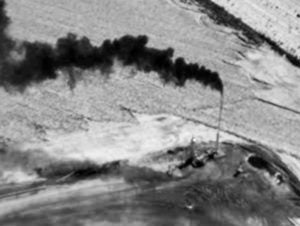New study finds flaring source of five times more pollution than previously thought
 A new study out today in the journal Science finds that climate-warming methane emissions from flaring, the practice of burning off gas rather than capturing it for productive use, are five times higher than government estimates — primarily due to unlit and malfunctioning flares. Researchers conclude that flares are combusting at a 91% efficiency rate, significantly lower than the 98% efficiency rate that is assumed by operators and policymakers.
A new study out today in the journal Science finds that climate-warming methane emissions from flaring, the practice of burning off gas rather than capturing it for productive use, are five times higher than government estimates — primarily due to unlit and malfunctioning flares. Researchers conclude that flares are combusting at a 91% efficiency rate, significantly lower than the 98% efficiency rate that is assumed by operators and policymakers.
These findings confirm that our current environmental standards are not adequately controlling this pollution source and underline the need for urgent regulatory action from the Environmental Protection Agency and Bureau of Land Management to limit pollution and waste from flaring.
Shedding light on the problem
The study, led by researchers at the University of Michigan, looked at flaring across three major U.S. oil and gas basins that collectively represent 80-90% of flaring nationwide. Scientists conducted 13 flights through these oilfields, sampling air downwind of flaring sites to determine how effectively flares were operating.
The prevalence of unlit or malfunctioning flares and the finding that average flaring efficiency is only 91% — as opposed to the assumed 98% — point to much more methane being emitted from flaring than previously thought. In fact, the University of Michigan estimates that poor flaring performance is creating excess methane pollution with the same climate impact every year as three million cars.
New study confirms flaring is a nationwide problem requiring urgent action Share on XFortunately, some energy producing states, including New Mexico and Colorado, have implemented rules to end routine flaring, a practice that creates unnecessary methane pollution and represents a significant waste of energy resources.
But these state efforts alone will not be enough to address the issue nationwide, and over 80% of the nation’s flaring problem is concentrated in just two states — Texas and North Dakota. Neither state has taken adequate steps to curb flaring or flaring emissions — placing the U.S. among the top five flaring countries in the world.
But the study also identified three major ways to reduce these emissions and mitigate the flaring problem:
- Reducing the total amount of flaring activity by building from leading state requirements and end pollution from routine flaring.
- Increasing flare efficiency, meaning working to amp up operational standards such as flare maintenance.
- Reducing the amount of unlit flares.
The lack of flaring controls by the country’s biggest flaring states makes it clear that the EPA and BLM need to step up and include measures to end pollution and waste from routine flaring in their forthcoming nationwide regulatory proposals.
A history of poor performance
This study is just one of several studies that have found similarly egregious emissions from flares. A recent helicopter survey done by researchers at EDF found that one in ten flares in the Permian Basin were unlit or malfunctioning, and collectively releasing at least 300,000 metric tons of unburned methane into the air.
This amount of waste comes at a huge cost. Energy Information Administration data indicates that the US wastes roughly $1 billion of gas on flares each year.
Meanwhile, on public lands over $400 million of gas was vented or flared in 2019 alone. That translates to roughly $50 million in lost revenue and taxpayer resources. Taxpayers for Common Sense found in a recent report that 82% of all gas losses on federal lands were due to flaring.
There are, however, widely available and cost-effective solutions to routine flaring. A recent Rystad cost analysis shows that many of these fixes are not just affordable for operators, but can even turn them a profit.
An opportunity for change
The science has once again affirmed that addressing routine flaring is vital to curbing climate pollution and protecting public health. This study illustrates that nationwide, malfunctioning and unlit flares are a massive source of methane emissions and co-pollutants that put our communities at risk.
This is a problem that leading states, like Colorado and New Mexico, are showing the way on, and that the international community is demanding action on. Just this summer the U.S. and EU introduced the Global Methane Pledge Energy Pathway, which calls for nations to end routine flaring as soon as possible and by 2030 at the latest.
We need strong EPA and BLM standards to reduce methane pollution and waste from flares nationwide.










